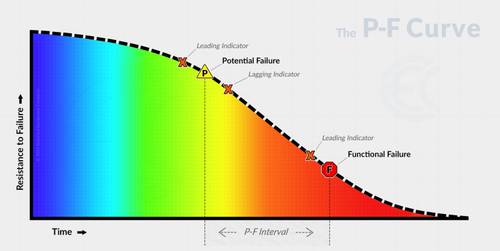Reliability Centered Maintenance vs Condition Based Maintenance
As part of our series on reliability and condition based maintenance programs, we are reviewing some of the fundamental terms of maintenance. This post will contrast reliability centered maintenance (RCM) and condition based maintenance (CBM).
Reliability Centered Maintenance
The field of reliability is well established with years of research and development originating in the military and aviation industries.
MIL standard 271C defines reliability as: “The probability that an item will perform its intended function satisfactorily for a specified interval under stated conditions.”
Over the years, maintenance has evolved to embrace concepts of reliability. This evolution gave rise to reliability centered maintenance. Reliability is usually measured as a percentage of mean time between failure. Reliability is a design attribute [1], expressing the system performance that can be expected. Maintenance is the action taken to preserve the system so it can continue to perform.
Most motor reliability programs are actually condition based maintenance programs designed to preserve the operation of the motor. More developed programs may incorporate failure analysis, energy management, motor repair practice, and replacement standards. Actual reliability programs are much more complex, where the goal is to manage risk in the most effective manner to ensure the function of systems. The key term is function.
“The development of a Reliability Centered Maintenance approach has provided a fresh perspective in which the purpose of maintenance is not to preserve assets for the sake of the assets themselves, but rather to preserve asset functions.” Ramesh Gulati
SAE standard JA1011 defines RCM as a specific process used to identify the policies that must be implemented to manage the failure modes that could cause the functional failure of any physical asset in a given operational context.
SAE JA1011 is a Surface Vehicle Aerospace standard that serves as a governing standard for RCM. The standard describes the minimum criteria that any process must possess to be deemed a compliant RCM process.
The requirements, in sequence, are:
- Determine the operational context, functions and associated desired standards of performance of the asset (operational context and functions).
- Determine how an asset can fail to fulfill its functions (functional failures).
- Determine the causes of each functional failure (failure modes).
- Determine what happens when each failure occurs (failure effects).
- Classify the consequences of failure (failure consequences).
- Determine what should be performed to predict or prevent each failure (tasks and task intervals).
- Determine if other failure management strategies may be more effective (one-time changes).
PM Optimization
This extensive process provides the variables of time and conditions required to maximize functional performance. The analysis of function, failure, and consequence provides a comprehensive maintenance optimization plan. A more detailed approach to RCM can be found in “Maintenance and Reliability Best Practices and Reliability Centered Maintenance.”
PM Optimization
“A process to optimize preventive maintenance (PM) tasks and frequencies to reduce likely failure modes by utilizing tools/techniques such as FMEA, RCM, and CBM.”[2]
Condition Based Maintenance (CBM) is another maintenance optimizing strategy. CBM uses non-intrusive technologies to inspect asset health and provides critical input and feedback to RCM.
Condition Based Maintenance
The objective of CBM is to “perform maintenance at a scheduled point in time when the maintenance activity is most cost-effective and before the asset loses optimum performance.”[3] Where RCM provides the structure plan, setting priorities to preserve functions, the role of CBM is to assess the health of assets with the intent to identify failure as early enough to limit consequences.
CBM programs provide necessary input into PM planning and effectiveness. A well-organized CBM program is, therefore, vital for both preventive maintenance and RCM. CBM also drives cost savings[4]:
- Maintenance costs: 15– 30% reduction
- Downtime: 20– 40% reduction
- Production: 15– 25% improvement
The P-F Interval
Early failure identification is the driver of most CBM methods, such as vibration analysis. In application, failure is described as stages along a curve to complete failure. The P-F Interval serves as the framework for discussion.
P– F Interval - The period between the point at which a potential failure becomes detectable and the point at which it degrades into a functional failure[5].
P – Potential failure. A pattern has progressed to a point where there is a potential to fail.
F – Functional failure. The system/asset will not perform its function as expected.

Typically there is no hard data to define the period that exists between P and F, as there are so many variables that would affect this. Therefore, the goal is to identify the potential as early as possible on the curve. Different methods and technologies provide for leading and lagging failure indication.
The best approach is to deploy methods providing the earliest detection (leading) before potential failure. This should allow repair activity to be scheduled and completed either before or within the P-F interval (and before functional failure).
When evaluating CBM methods, such as motor circuit analysis, it is important to use known cases to help estimate how early failures can be identified. This will help define the frequency of activity (monthly, quarterly, yearly). Another important aspect is to evaluate how long it typically takes to remediate problems. For example, if a potential failure is identified (P), how much estimated time could exist before failure and how long will it take to schedule an outage for repairs?
Citations:
[1] Gulati, Ramesh (2012-08-17). Maintenance Best Practices. Industrial Press, Inc.
[2] The Professional’s Guide to Maintenance and Reliability Terminology by Ramesh Gulati, Jerry Kahn and Robert Baldwin
[3] Gulati, Ramesh (2012-08-17). Maintenance Best Practices. Industrial Press, Inc.
[4] Gulati, Ramesh (2012-08-17). Maintenance Best Practices. Industrial Press, Inc
[5] SAE JA1011, Evaluation Criteria for Reliability-Centered Maintenance










